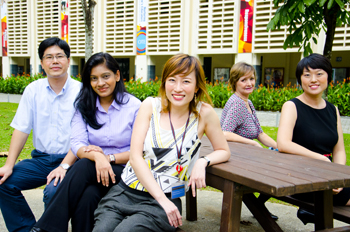Why Singapore’s English Teachers Should Embrace Singlish, Not Fight It
Is it time for Singaporean educators to embrace Singlish as a legitimate learning tool? What the Research […]
Read More
Read, review and edit 40 essays on the same topic – this is familiar to language teachers. These steps are essential for a good piece of writing, but it sure is a lot of work. What if the students are the ones doing it – and enjoying it?
Imagine an English classroom where the students take on the role of the teacher and assess each other’s work.
For every piece of writing they do, they receive four to five reviews from their classmates. Each piece of constructive feedback is anonymous. With the feedback, they revise and then rewrite a second draft.

(From left) Cho Young Hoan, Anita Devi Pillai, Daphnee Lee, Mary Ellis and Mimi Shin
At the same time, they also provide feedback for an article they are assigned to read. And they don’t know who the author is.
This is made possible by a Web-based peer review system, called SWoRD (Scaffolded Writing and Rewriting in the Discipline), which allows students to upload and review articles anonymously.
The key to this is the anonymity of it all. It gives students the opportunity to think and write both as a writer and a reviewer. And it sure makes the writing process a lot of fun.
“Students write from the perspective of a writer,” explains Research Scientist and Principal Investigator Dr Cho Young Hoan. “But by reviewing other people’s papers, they can also get the perspectives of the reviewers and use it on their own paper.”
With four other researchers, Young tested SWoRD in a few classes at NIE with the intent to introduce it to secondary schools in 2013. They found that this new method of assessment reaps several benefits, mainly in promoting critical thinking and constructive learning among students.
While a typical peer assessment process may see students writing feedback just because they have to, students using SWoRD were seen to be more motivated to give quality feedback.
– Daphnee Lee, Office of Education Research
Centred around the idea of anonymity, the peer review procedure turns into a constructive process that takes away the element of “mutual gratitude” where friends tend to give each other good reviews without much thought.
“It is not just an ‘I pat your back, you pat mine’ kind of thing,” says Dr Mary Ellis, one of the Co-Principal Investigators (Co-PIs). This is because of the anonymity of the whole process.
Where previously students were more concerned about not hurting their friend’s feelings, the anonymity in SWoRD allows students to give and receive more open and constructive feedback.
The students who authored the paper are also able to score the feedback they receive based on its quality. Known as back-review, this encourages students to put a lot more thought and effort into constructing their feedback.
As students consider how to respond to the reviews they receive – what to use, what not to use, and why – they also learn to think critically and to be flexible in their writing and thinking.
“Students find it useful because they may not notice the gaps in their own writings so they learn through reviewing others’ work,” notes Co-PI Dr Anitha Devi Pillai.
“Students have greater autonomy in terms of what they learn through peer assessment,” adds Co-PI Dr Daphnee Lee.
For SWoRD to succeed, “The perceptions of peer assessment are crucial,” says Young.
– Cho Young Hoan, Office of Education Research
They found that students who perceive the concept of peer assessment positively showed active participation in giving and receiving peer feedback. Likewise for teachers, they have to welcome the concept in order to confidently facilitate the entire peer assessment process.
Am I competent enough to facilitate peer assessment? Will the students be able to handle it? These are some doubts that teachers who are new to this idea tend to have.
To help teachers ease into the new pedagogy, Young and his team will conduct training sessions in schools. Teachers will be trained in how to identify key features of a quality review and to help students integrate the feedback into their final articles.
At the end of the day, it’s really about the students. “We want to see the improvements in the writing quality, not so much the scores of the feedback,” says Young.